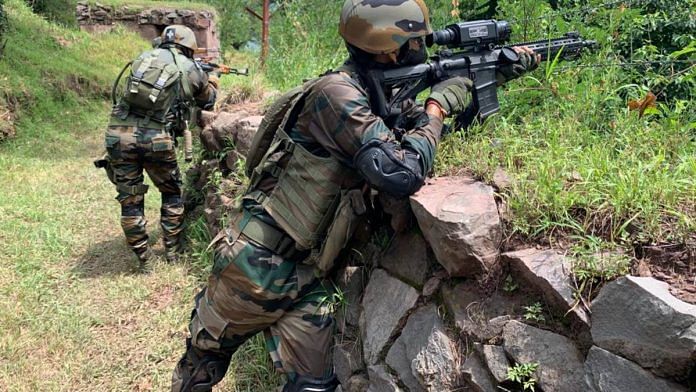Poonch/Bhimber Gali: Over the past few years, India’s frontline soldiers have witnessed a slow but massive technology transformation, not just in terms of weapons, lighter bulletproof jackets, ballistic helmets but also in getting situational awareness of their area of operations.
Be it along the Line of Control (LoC) with Pakistan or the Line of Actual Control (LAC) with China, the average infantry soldier is better equipped, something which was earlier unique to the Special Forces.
ThePrint, which was on a visit to the LoC recently, witnessed new systems that have been deployed, which makes the soldier more aware of his surroundings, besides getting new protective and firing gears.
“The regular infantry soldier along the LoC has indeed seen a massive transformation. He is better equipped, has lighter gear to carry, and is more aware of his area of operations,” a source in the defence establishment said.
Sources point out that the biggest reason behind this technological upgrade is the emergency financial powers that have been delegated to Army Headquarters for procurement of equipment besides the already existing Army Commanders’ Special Financial Powers (ACSFP).
The emergency procurement powers were given to the Services immediately after the 2016 surgical strikes and also after the Balakot strikes and during the ongoing standoff with China along the LAC.
Amid all the seven Commands, the Northern Command gets the biggest chunk, both in terms of emergency procurement and also the ACSFP.
What will pave the way for further faster procurement of Command specific items is the decision of the Narendra Modi government in March this year to delegate financial powers under capital procurement to Command heads of Army, the Air Force, and the Navy to make expenses to the tune of Rs 100 crore at their own discretion.
Also read: China revises Galwan Valley clash toll to 5, says PLA troops were ‘besieged’
Better equipped soldiers
One of the biggest changes that the frontline infantry soldier has seen is in the area of firepower.
The soldiers have now got more lethal firepower in the form of the SiG 716 rifle that was bought from the US under the emergency procurement clause.
“The rifle has a better range, accuracy, and lethality than the AK-47s. It is way better than the INSAS,” a source said.
Another big change has been the bulletproof jackets. The soldier now wears a much lighter jacket, weighing about 3.3 kg, which makes mobility easier.
Since the terrain in which the soldiers operate in are slippery and mountainous, they have also been given protective pads which will bear the impact of any fall and also help in crawling when needed.
These particular items were in limited numbers earlier, but now most of the soldiers have them. The troops now also have ballistic helmets which give their heads all-around protection, unlike in the earlier ones.
The Northern Command has also gone in for procurement, though in limited numbers, of the US-made Exfil ballistic helmets, regarded as the finest in the world.
These helmets were first procured by the Special Forces of the Army, but are now available for selected groups of regular infantry soldiers.
These helmets can also be fixed with a night vision camera and the idea is to have all soldiers who are out for operations along the LoC to have individual secured communication sets.
Also read: Why setting up integrated theatre commands should not be rushed — former service chiefs explain
Investment in cameras and drones
The Army has not just focused on equipping the soldiers with arms and lighter load, but also on giving better situational awareness.
“All these are geared to help him fight the enemy in a much better way,” a second source said.
The biggest addition has been the use of tactical drones. These drones are of different make and can easily be operated by a soldier to carry out surveillance of the area around him.
Along with this, another big factor has been the investment in hi-tech cameras in multiple locations along the LoC.
These cameras have night vision as well as infra-red capabilities and are basically meant to spot infiltrators.
“We have been using cameras for a long time but we now have a wider coverage. The next step is to have artificial intelligence-enabled cameras that will be able to send an alarm back as soon as it detects infiltration,” a third source said.
Some of the more specialised, indigenously-built cameras, installed at various Army posts along the LoC, have the capability of longer zooms and can pick up movements happening in Pakistani positions.
Asked if Pakistan has such cameras, a source quoted above said, “Pakistanis also have cameras, but in limited supply. What works to our advantage is that our products are indigenous and have high range and clarity”.
Such is the capability of the integrated cameras being used that somebody sitting at the Army headquarters in Delhi can watch the live feed from the LoC.
(Edited by Poulomi Banerjee)
Also read: Why induction of American MH-60 Romeo choppers is good news for Indian Navy



